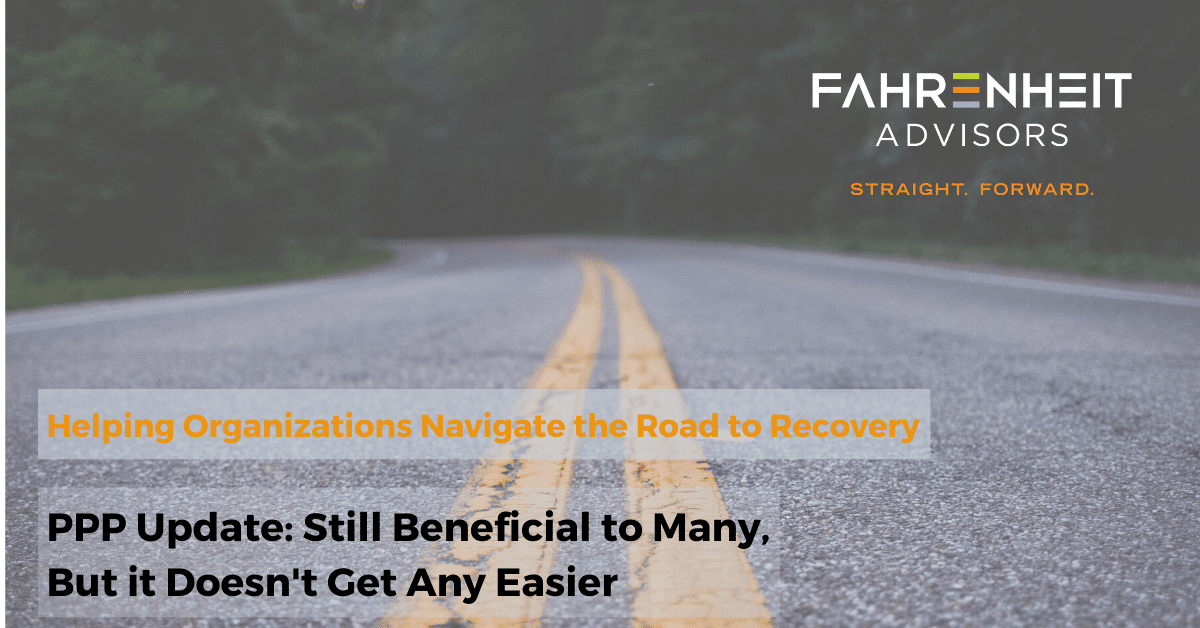PPP Update…Still Beneficial to Many, But it Doesn’t Get Any Easier
 The Paycheck Protection Program established under the CARES Act has been the hot topic of conversation for the last month…articles, webinars and thousands of hours of discussions and arguments among tax and financial professionals. While we still believe the program will be beneficial to many organizations, the more we learn, the more we understand that the program will generally be less beneficial than was originally hoped. Here’s why:
The Paycheck Protection Program established under the CARES Act has been the hot topic of conversation for the last month…articles, webinars and thousands of hours of discussions and arguments among tax and financial professionals. While we still believe the program will be beneficial to many organizations, the more we learn, the more we understand that the program will generally be less beneficial than was originally hoped. Here’s why:
1) Difficult to get full forgiveness
We have looked at a lot of scenarios, and based on the language in the Act and the positions taken by the SBA to date, it appears that it will be very difficult to get full forgiveness for a PPP loan, even if the funds are all spent on allowable expenses. Without going into mind numbing detail, let’s just say that based on what we know now, the interplay of the various definitions and formulas make it almost impossible.
2) Lack of guidance on forgiveness
In #1 I said, “Based on what we know now”, because the promised guidance from the SBA specifically covering forgiveness has not yet been issued. We recently heard a rumor that the guidance could still be weeks away, leaving borrowers and their advisors no choice but to try to make reasonable assumptions about what the final forgiveness rules will be.
3) Lack of income tax deductibility
On April 30, the IRS confirmed what many had feared with the issuance of Notice 2020-32. Expenses paid with forgiven PPP funds will NOT be deductible for income tax purposes. The forgiveness of the debt will still not be considered taxable income, but the deduction for the related expenses will not be permitted.
4) Changing the rules in the middle of the game
The SBA and the Treasury Department have decided that they can create provisions in the PPP program that were NOT included in the actual language of the CARES Act. While primarily intended to shame large, public companies into returning their PPP loan proceeds, the language can be interpreted to apply to privately-owned businesses as well. This has left many owners wondering if their good faith determination of eligibility for a PPP loan, based on the rules in force at the time, could be second guessed after the fact.
So what are you supposed to do?
Based on all of these factors, here is what we are recommending to our clients:
- Stop wasting time and effort on what you can’t control:
- Accept that you will end up with a 2-year, 1% loan for the amount of your PPP loan that is not forgiven. Not too bad.
- Accept that you will not get a tax deduction for costs paid with forgiven debt. Your cash outlay was a net of zero anyway.
- Expect the politicians and the bureaucracy to send confusing and mixed signals about the PPP program for the next few months, including statements to encourage borrowers to pay back their PPP loans.
- Focus on what you CAN be doing:
- Running your business and not reading countless articles speculating on PPP forgiveness!
- If your goal is to maximize PPP loan forgiveness based on what we know now:
- Maintain/increase your full-time equivalent headcount to base levels, as long as it makes business sense to do so.
- Don’t reduce any employee’s pay by more than 25%.
- Assume the cash basis of accounting and make sure you pay 8 weeks of payroll related costs and 2 months of rent, utilities and interest on mortgages.
- Document your decision to apply for and accept the PPP loan. Remember, your certifications were probably something like:
- Current economic uncertainty makes this loan request necessary to support the ongoing operations of the Applicant.
- The funds will be used to retain workers and maintain payroll or make mortgage interest payments, lease payments, and utility payments, as specified under the Paycheck Protection Program Rule.
Make sure that your documentation supports your certifications at the time they were made. If so, you made a good faith effort to comply with the regulations in place at that time. If not, you probably should not have applied for the PPP loan and should discuss with your advisors whether you should be returning the proceeds by May 7, 2020. If your loan agreement included additional certifications, make sure that they are true and correct at the time you make them.
And, as always, let us know how we can help-Experts@fahrenheitadvisors.com.
Due to the rapidly changing regulations and program specifics, some items in this post may have changed since the publication date. Companies should continue to monitor the US Treasury and SBA websites for updates.
 About the Author
About the Author
Doug Jones provides fractional CFO and senior financial management services to small and midsize organizations. In addition to improving his clients’ accounting and finance operations, Doug frequently serves as the link between company owners and outside advisors including attorneys, CPAs, investment bankers, appraisers, and personal financial advisors. He is skilled in identifying and integrating the full range of financial and non-financial business issues in contract negotiations and resolution of business decisions.